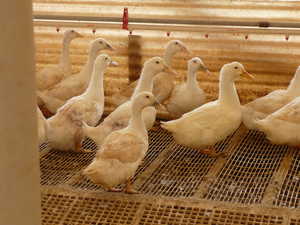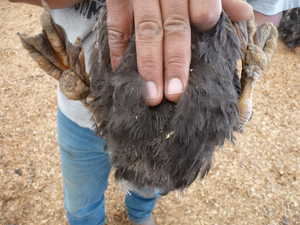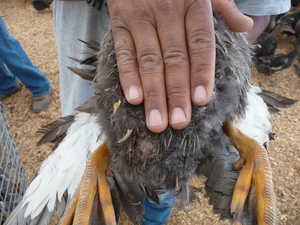Thursday, August 5, 2010
There are several ways to determine which of your ducks are laying eggs. No one indication is proof positive but collectively they can give you a good indication of which birds are laying eggs. During the middle of every summer, we use these criteria in our duck breeder flocks to remove nonlaying birds. If, for example, we can go through a breeder flock of 500 Rouen ducks, remove half the birds but only drop the egg production a little bit (due to the inadvertent culling of laying birds), we are much better off. We have just cut our feed, water and bedding bill in half with barely any loss in egg production!
If you have Pekins, look at their bill. If it is bright orange, they are probably not laying. Those birds that have been laying for quite awhile have a washed out, pale bill. Prior to production most Pekin ducks will accumulate xanthophylls in their bill and feet. Xanthophylls are a pigment in corn, alfalfa, and some other feed ingredients. But as the ducks start to lay, those xanthophylls are deposited in the yolk of the egg. With high egg production, more xanthophylls are deposited in the eggs than absorbed in the feed, causing their bills and feet to become lighter and lighter in color.
If you have Pekins, look at their bill. If it is bright orange, they are probably not laying. Those birds that have been laying for quite awhile have a washed out, pale bill. Prior to production most Pekin ducks will accumulate xanthophylls in their bill and feet. Xanthophylls are a pigment in corn, alfalfa, and some other feed ingredients. But as the ducks start to lay, those xanthophylls are deposited in the yolk of the egg. With high egg production, more xanthophylls are deposited in the eggs than absorbed in the feed, causing their bills and feet to become lighter and lighter in color.

In this group of Pekins, the female on the right is probably not laying. Notice her bill and feet are darker orange and her feathers are bright and clean which means she has recently molted. The female in the front left is probably laying well. She has all her feathers but they are dirty, original feathers meaning she has not molted. The female in the left back is missing her flight feathers which means she is now going through a molt and probably not laying.
The best way to know if your birds are laying is to catch them and measure the distance between their pelvic bones. If the birds are laying, their pelvic bones are flexible and wide apart to allow passage of the egg. If they are not laying, they are close together and rather stiff and nonpliable. You do not have to turn the duck over to do this. Just pick them up and slide your hand under their abdomen down to their pelvis. Is the distance between the bones two fingers or three fingers or four fingers? The more fingers you can get between their pelvic bones, the better chance they are laying eggs now. Of course the larger breeds will naturally have more space between their pelvic bones so you need to compare among birds of the same breed or size.
The best way to know if your birds are laying is to catch them and measure the distance between their pelvic bones. If the birds are laying, their pelvic bones are flexible and wide apart to allow passage of the egg. If they are not laying, they are close together and rather stiff and nonpliable. You do not have to turn the duck over to do this. Just pick them up and slide your hand under their abdomen down to their pelvis. Is the distance between the bones two fingers or three fingers or four fingers? The more fingers you can get between their pelvic bones, the better chance they are laying eggs now. Of course the larger breeds will naturally have more space between their pelvic bones so you need to compare among birds of the same breed or size.

The pelvic bones are only two fingers apart in this female Rouen - she is not laying.

The pelvic bones are four fingers apart in this female. She is definitely laying!
On our next blog we will give you the results of our first cull. How efficient were they in removing the non-layers? What was our egg production before and after the cull?
On our next blog we will give you the results of our first cull. How efficient were they in removing the non-layers? What was our egg production before and after the cull?